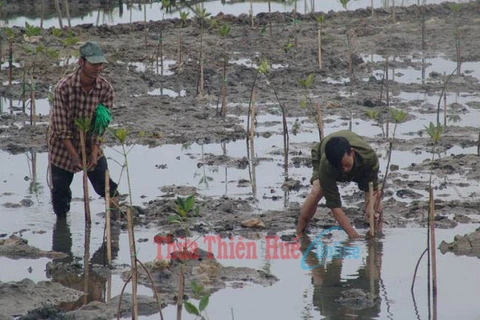Yen Bai (VNA) - Residents of Mu Cang Chai District in the northern mountainous province of Yen Bai are enjoying better lives thanks to their special ethnic fruit called Son Tra.
Son Tra (scientifically named Docynia indica) is an indigenous tree species widely found at high elevations in northern Vietnam.
Its fruit is traditionally used as food and for making wine, providing a source of income for farmers.
From growing wild in the forests, in recent years the trees have become a commodity helping residents escape poverty and even make money, the Tin Tuc (News) Newspaper reports.
The biggest forest of Son Tra cultivation is in Lao Chai Commune.
Lo A Chu , a H’mong tribe member, told the newspaper that his family had earned about 20million-30million VND (900-1,400 USD ) from this year’s crop.
“This was my family’s Son Tra forest, which is about 10-years-old, so the fruits were not as big as those from older trees”, said Chu . “But other families could get much more because their trees were more perennial,” he told the News.
According to Lo A Chu , the tree used to grow wildly in the forests and no one wanted to pick the fruit because they could not be sold.
But in recent years, the fruits have begun selling and like other families in the commune, Lo A Chu ’s family expanded the Son Tra cultivation area.
So far, his family has 2ha of Son Tra, half of which has provided income regularly, the paper said.
Like many H’mong households in Mu Cang Chai, his family’s income comes from growing fruit of the Thao Qua (another special tree in the northern mountainous region) and Son Tra.
“My 10-member family live on growing Thao Qua and Son Tra trees. In recent years, the weather has changed abnormally, which caused damaged the Thao Qua crop. But fortunately, my family had a fallback - the Son Tra,” the H’mong farmer said.
Another local, Sung A Chinh, said happily that his family earned 60,000 million VND (2,700 USD ) from more than 2ha of Son Tra.
Le Trong Khang, Deputy Head of the Mu Cang Chai District, told the newspaper that authorities have been encouraging local growers to expand the cultivated areas in the region.
The Son Tra tree was placed on a list of trees for afforestation for many years, he said. But since 2000, the district has found there are many economic and agricultural advantages to the tree.
“The Son Tra tree has a big leaf canopy and roots digging deeply into the soil. Thus the tree is good for preventing land erosion, too,” he said.
“The Son Tra flowers are good for beekeeping. The fruits are not only used as natural medicine but also as an ingredient for drinks,” Khang said.
At present, the district has a total of about 2,000ha of Son Tra. This year, the district yielded about 2,500 tonnes of the fruits with prices ranging from 15,000-40,000 VND (0.7 US cents – 1.8 USD ).
Under the plan of Yen Bai Province’s agriculture and rural development sector, the cultivation areas will be expanded to 10,000ha by the year 2020, he said.-VNA

Lao Cai enlarges cinnamon cultivation acreage
The northern province of Lao Cai will scale up its cinnamon plantations to 25,000 hectares by 2025, a 2.5-fold increase from current land use.























